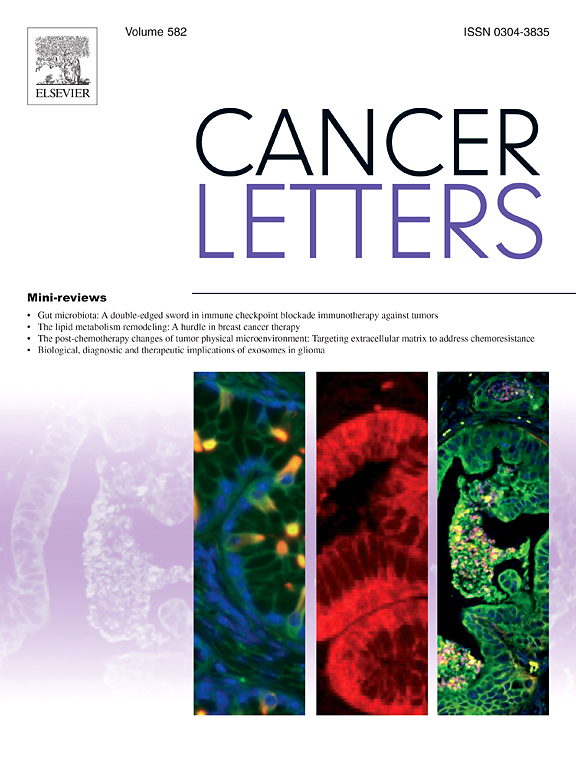KAP1 promotes gastric adenocarcinoma progression by activating Hippo/YAP1 signaling via binding to HNRNPAB
IF 9.1
1区 医学
Q1 ONCOLOGY
引用次数: 0
Abstract
Gastric adenocarcinoma (GAC) remains a significant global health challenge, with over a million new cases annually. Peritoneal carcinomatosis (PC), detected in ∼20% of cases at diagnosis and ∼45% later, is uniformly fatal, with limited treatment options. This study investigated the role of KAP1 in GAC progression, focusing on its interaction with YAP1 and cancer stemness traits. Analysis of over 596 primary GACs and 72 PC samples revealed that high nuclear KAP1 expression correlates with poor prognosis. KAP1 knockdown reduced oncogenic activity and stemness traits in GAC cells. Mechanistically, KAP1 positively regulates YAP1 transcription by binding to its promoter and reducing H3K27ac levels. Mass spectrometry identified an interaction between KAP1 and HNRNPAB, further modulating YAP1 signaling. Expression of the KRAB domain of ZFP568 without its DNA-binding zinc fingers inhibited both KAP1 and YAP1 expression, significantly reducing colony formation and tumor growth in vivo. Additionally, emerging antisense oligonucleotides (ASOs) targeting KAP1 or YAP1 effectively suppressed mouse tumor progression. These findings establish KAP1 as a critical driver of tumor progression in GAC through YAP1 regulation and HNRNPAB interaction, highlighting its potential therapeutic target. This study advances our understanding and offers a preclinical framework to improve outcomes for GAC.
KAP1通过与HNRNPAB结合激活Hippo/YAP1信号,从而促进胃腺癌的进展。
胃腺癌(GAC)仍然是一个重大的全球健康挑战,每年有超过一百万的新病例。腹膜癌(PC)在诊断时约占20%,诊断后约占45%,通常是致命的,治疗方案有限。本研究探讨了KAP1在GAC进展中的作用,重点研究了其与YAP1和癌干性性状的相互作用。596例原发性GACs和72例原发性PC的分析显示,核KAP1高表达与预后不良相关。KAP1敲低可降低GAC细胞的致癌活性和干性性状。从机制上讲,KAP1通过与YAP1启动子结合并降低H3K27ac水平,正向调节YAP1的转录。质谱分析发现KAP1和HNRNPAB之间存在相互作用,进一步调节YAP1信号。无dna结合锌指的ZFP568的KRAB结构域的表达抑制了KAP1和YAP1的表达,显著减少了体内集落的形成和肿瘤的生长。此外,新出现的针对KAP1或YAP1的反义寡核苷酸(ASOs)可有效抑制小鼠肿瘤进展。这些发现表明KAP1通过YAP1调控和HNRNPAB相互作用在GAC中作为肿瘤进展的关键驱动因素,突出了其潜在的治疗靶点。这项研究促进了我们的理解,并提供了一个临床前框架来改善GAC的预后。
本文章由计算机程序翻译,如有差异,请以英文原文为准。
求助全文
约1分钟内获得全文
求助全文
来源期刊

Cancer letters
医学-肿瘤学
CiteScore
17.70
自引率
2.10%
发文量
427
审稿时长
15 days
期刊介绍:
Cancer Letters is a reputable international journal that serves as a platform for significant and original contributions in cancer research. The journal welcomes both full-length articles and Mini Reviews in the wide-ranging field of basic and translational oncology. Furthermore, it frequently presents Special Issues that shed light on current and topical areas in cancer research.
Cancer Letters is highly interested in various fundamental aspects that can cater to a diverse readership. These areas include the molecular genetics and cell biology of cancer, radiation biology, molecular pathology, hormones and cancer, viral oncology, metastasis, and chemoprevention. The journal actively focuses on experimental therapeutics, particularly the advancement of targeted therapies for personalized cancer medicine, such as metronomic chemotherapy.
By publishing groundbreaking research and promoting advancements in cancer treatments, Cancer Letters aims to actively contribute to the fight against cancer and the improvement of patient outcomes.
 求助内容:
求助内容: 应助结果提醒方式:
应助结果提醒方式:


